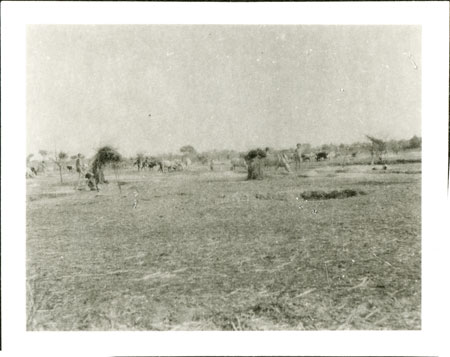Nuer wells

40 x 30 mm | Print 35mm contact
There are records relating to alternative images that we do not have scans for in the database:
1998.346.74.1 - Negative film nitrate , (40 x 30 mm)
1998.346.74.1 - Negative film nitrate , (40 x 30 mm)
Date of Print:
Unknown
Previous PRM Number:
EP.N.74
Previous Other Number:
4
Accession Number:
1998.346.74.2
Description:
Cattle and some men standing near wells dug in a dry river bed (possibly the Nyanding stream) used by Jimac and Gaaliek secondary sections of the Mor primary section of the Lou.
This practice seems to have been restricted to the Lou and Eastern Jikany Nuer tribes, although less so after their territorial advance as far as the Sobat River and other rivers.
It involved re-digging each season to provide a water source of about a foot in depth.
Troughs for cattle were often placed around the holes, which belonged to a household.
Photographer:
Edward Evan Evans-Pritchard
Date of Photo:
?1931
Region:
[Southern Sudan] Upper Nile or Jonglei
Group:
Nuer ?Lou
PRM Source:
Edward Evan Evans-Pritchard
Acquired:
Donated 1966
Other Owners:
E. E. Evans-Pritchard Collection
Class:
Water Supply , Animal Husbandry
Keyword:
Well , Animal Cattle
Documentation:
Original catalogue lists in Manuscript Collections. Additional material in related documents files. [CM 27/9/2005]
Primary Documentation:
Accession Book Entry: [p.
98] 1966.27 [1 - 24] G[ift] PROFESSOR E.
E.
EVANS-PRITCHARD; INST.
OF SOCIAL ANTHROPOLOGY, 51 BANBURY RD.
OXFORD 1966.27.17 S.
SUDAN.
NUER TRIBE.
Box of negatives each in separate envelope, labelled.
(some missing).
Nos.
1 - 213.
(prints in box 1966.27.18)...1966.27.18 S.
SUDAN.
NUER TRIBE.
Box of prints each in separate envelope.
Nos.
1 - 213.
(negatives in 1966.27.17.)
Manual Catalogues [typewritten, entitled "Nuer Photographs (E-P)"] - 74. Wells. (S.) [Small size]
Note on print reverse ms pencil - "4 74 "
Manual Catalogues [typewritten, entitled "Nuer Photographs (E-P)"] - 74. Wells. (S.) [Small size]
Note on print reverse ms pencil - "4 74 "
Other Information:
In The Nuer (Oxford University Press, 1940) page 58-59, E.
E.
Evans-Pritchard notes that 'only in parts of Lou, Gaawar, and Eastern Jikany, as far as is known, are they regularly forced to dig wells in the beds of streams at the height of the drought.
Twenty years ago this was probably more customary among the Lou than today, for they had not then the undisputed access to open water that more sections now enjoy.
The wells, which have to be redug each year, are two to three feet in diameter and twenty to thirty feet in depth, and their excavation takes two or three days of hard labour.
The water, about a foot deep, is clean and fresh and the wells are frequently cleaned out, steps being cut in the walls for this purpose (Plate XVb).
Each household has its own well which is surrounded by shallow mud troughs where the cattle are watered three times daily.' [Chris Morton 23/3/2004]
Recorder:
Christopher Morton 6/4/2004 [Southern Sudan Project]

